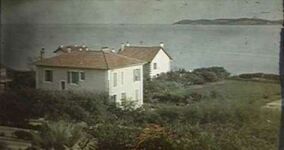Lippmann plate

Early colour photograph by Lippmann
Gabriel Lippmann conceived a two-step method to record and reproduce colours, variously known as direct photochromes,[1]interference photochromes,[1]Lippmann photochromes,[1]Photography in natural colours by direct exposure in the camera[1] or the Lippmann process of colour photography.[2] Lippmann won the Nobel Prize in Physics for this work in 1908.
A Lippmann plate is a clear glass plate (having no Anti-halation backing), coated with an almost transparent (very low silver halide content) emulsion of extremely fine grains, typically 0.01 to 0.04 micrometres in diameter.[3]
Consequently, Lippmann plates have an extremely high resolving power[4] exceeding 400 lines/mm.
Contents
1 Method
2 Other sources of Lippmann plates
3 References
4 External links
Method
In Lippmann's method, a glass plate is coated with a "grainless" (ultra fine grain [5]) colour-sensitive film using the Albumen Process containing potassium bromide, dried, sensitized in the silver bath, washed, flowed with cyanine solution, dried and then brought into optical contact with a reflection surface; the back of the plate is then flowed in a plate holder of special form with pure mercury and exposed in the camera through the glass side of the plate so that the light rays which strike the transparent light-sensitive film are reflected in themselves and create interference phenomena of stationary waves.[1] The standing waves cause exposure of the emulsion in diffraction patterns. The developed and fixated diffraction patterns constitute a Bragg condition in which diffuse, white light is scattered in a specular fashion and undergo constructive interference in accordance to Bragg's law.[6] The result is an image having very similar colours as the original using a black and white photographic process.
For this method Lippmann won the Nobel Prize in Physics in 1908.[7]
The colour image can only be viewed in the reflection of a diffuse light source from the plate, making the field of view limited, and it cannot be copied. The technique was very insensitive with the emulsions of the time and it never came into general use. Another reason Lippmann's process of colour photography did not succeed can be found in the invention of the autochrome plates by the Lumière brothers.[1] Lippmann photographic techniques are being developed to produce images which can easily be viewed, but not copied, for security purposes.[8]
Other sources of Lippmann plates
- The Kodak Spectroscopic Plate Type 649-F is specified with a resolving power of 2000 lines/mm.[9]
- A diffusion method for making silver bromide based holographic recording material[10]
References
^ abcdef Eder, J.M. (1945) [1932]. History of Photography, 4th. edition [Geschichte der Photographie]. New York: Dover Publications. pp. 668, 670, 671, 672. ISBN 0-486-23586-6..mw-parser-output cite.citationfont-style:inherit.mw-parser-output .citation qquotes:"""""""'""'".mw-parser-output .citation .cs1-lock-free abackground:url("//upload.wikimedia.org/wikipedia/commons/thumb/6/65/Lock-green.svg/9px-Lock-green.svg.png")no-repeat;background-position:right .1em center.mw-parser-output .citation .cs1-lock-limited a,.mw-parser-output .citation .cs1-lock-registration abackground:url("//upload.wikimedia.org/wikipedia/commons/thumb/d/d6/Lock-gray-alt-2.svg/9px-Lock-gray-alt-2.svg.png")no-repeat;background-position:right .1em center.mw-parser-output .citation .cs1-lock-subscription abackground:url("//upload.wikimedia.org/wikipedia/commons/thumb/a/aa/Lock-red-alt-2.svg/9px-Lock-red-alt-2.svg.png")no-repeat;background-position:right .1em center.mw-parser-output .cs1-subscription,.mw-parser-output .cs1-registrationcolor:#555.mw-parser-output .cs1-subscription span,.mw-parser-output .cs1-registration spanborder-bottom:1px dotted;cursor:help.mw-parser-output .cs1-ws-icon abackground:url("//upload.wikimedia.org/wikipedia/commons/thumb/4/4c/Wikisource-logo.svg/12px-Wikisource-logo.svg.png")no-repeat;background-position:right .1em center.mw-parser-output code.cs1-codecolor:inherit;background:inherit;border:inherit;padding:inherit.mw-parser-output .cs1-hidden-errordisplay:none;font-size:100%.mw-parser-output .cs1-visible-errorfont-size:100%.mw-parser-output .cs1-maintdisplay:none;color:#33aa33;margin-left:0.3em.mw-parser-output .cs1-subscription,.mw-parser-output .cs1-registration,.mw-parser-output .cs1-formatfont-size:95%.mw-parser-output .cs1-kern-left,.mw-parser-output .cs1-kern-wl-leftpadding-left:0.2em.mw-parser-output .cs1-kern-right,.mw-parser-output .cs1-kern-wl-rightpadding-right:0.2em
^ US 6556992
^ R.W.G. Hunt, The Reproduction of Colour, 6th ed, p6
^ https://web.archive.org/web/20100724065137/http://www.tpub.com/content/photography/14209/css/14209_56.htm
^ "Recent developments in Lippman photography", Jean-Marc Fournier, Benjamin R. Alexander, et al.;Proc. SPIE 3358, 95 (1998)
^ Bragg diffraction
^ http://nobelprize.org/nobel_prizes/physics/articles/biedermann/index.html
^ Lippmann Security
^ Kodak Plates and Films for Scientific Photography. Rochester: Eastman Kodak Company. 1973. p. 13d. ISBN 0-87985-083-3.
^ Blyth, Jeff; Roger B. Millington; Andrew G. Mayes; Christopher R. Lowe, "A diffusion method for making silver bromide based holographic recording material", Institute of Biotechnology, University of Cambridge, Tennis Court Road, Cambridge, archived from the original on January 28, 2010, retrieved July 25, 2010
External links
- Lippmann Wiki for experimenters
- Forum for the Lippmann Process
Wikimedia Commons has media related to: Gabriel Lippmann (category) |